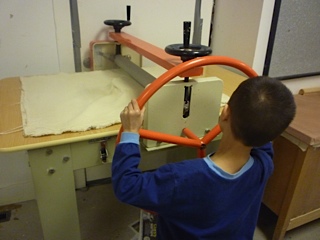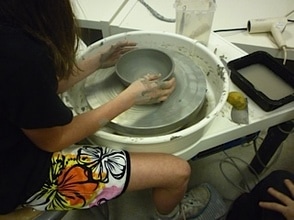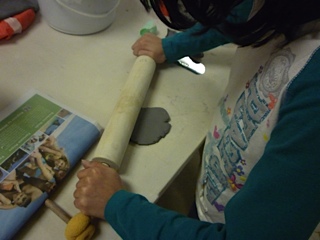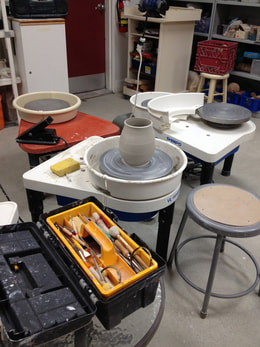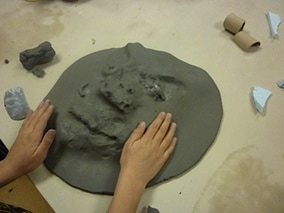For more up-to-date information and to register, please visit the Delta Parks and Recreation website.
Delta Parks and Recreation website
Delta Parks and Recreation website
The Guild has a great variety of potters that use the following methods
and pottery can be shaped by a range of methods that include:
Hand building
This is the earliest forming method. Wares can be constructed by hand from coils of clay, combining flat slabs of clay, or pinching solid balls of clay or some combination of these. Parts of hand-built vessels are often joined together with the aid of slip, an aqueous suspension of clay body and water. A clay body can be decorated before or after firing. Prior to some shaping processes, clay must be prepared such as tablewares although some studio potters find hand-building more conducive to create one-of-a-kind works of art.
Throwing
A potter shapes a piece of pottery on an electric-powered potter's wheel. In a process called "throwing" a ball of clay is placed in the centre of a turntable, called the wheel-head, which the potter rotates with a stick, with foot power or with a variable-speed electric motor.
During the process of throwing, the wheel rotates rapidly while the solid ball of soft clay is pressed, squeezed and pulled gently upwards and outwards into a hollow shape. The first step of pressing the rough ball of clay downward and inward into perfect rotational symmetry is called centring the clay—a most important skill to master before the next steps: opening (making a centred hollow into the solid ball of clay), flooring (making the flat or rounded bottom inside the pot), throwing or pulling (drawing up and shaping the walls to an even thickness), and trimming or turning (removing excess clay to refine the shape or to create a foot).
Considerable skill and experience are required to throw pots of an acceptable standard and, while the ware may have high artistic merit, the reproducibility of the method is poor. Because of its inherent limitations, throwing can only be used to create wares with radial symmetry on a vertical axis. These can then be altered by impressing, bulging, carving, fluting, and incising. In addition to the potter's hands these techniques can use tools, including paddles, anvils & ribs, and those specifically for cutting or piercing such as knives, fluting tools and wires. Thrown pieces can be further modified by the attachment of handles, lids, feet and spouts.
and pottery can be shaped by a range of methods that include:
Hand building
This is the earliest forming method. Wares can be constructed by hand from coils of clay, combining flat slabs of clay, or pinching solid balls of clay or some combination of these. Parts of hand-built vessels are often joined together with the aid of slip, an aqueous suspension of clay body and water. A clay body can be decorated before or after firing. Prior to some shaping processes, clay must be prepared such as tablewares although some studio potters find hand-building more conducive to create one-of-a-kind works of art.
Throwing
A potter shapes a piece of pottery on an electric-powered potter's wheel. In a process called "throwing" a ball of clay is placed in the centre of a turntable, called the wheel-head, which the potter rotates with a stick, with foot power or with a variable-speed electric motor.
During the process of throwing, the wheel rotates rapidly while the solid ball of soft clay is pressed, squeezed and pulled gently upwards and outwards into a hollow shape. The first step of pressing the rough ball of clay downward and inward into perfect rotational symmetry is called centring the clay—a most important skill to master before the next steps: opening (making a centred hollow into the solid ball of clay), flooring (making the flat or rounded bottom inside the pot), throwing or pulling (drawing up and shaping the walls to an even thickness), and trimming or turning (removing excess clay to refine the shape or to create a foot).
Considerable skill and experience are required to throw pots of an acceptable standard and, while the ware may have high artistic merit, the reproducibility of the method is poor. Because of its inherent limitations, throwing can only be used to create wares with radial symmetry on a vertical axis. These can then be altered by impressing, bulging, carving, fluting, and incising. In addition to the potter's hands these techniques can use tools, including paddles, anvils & ribs, and those specifically for cutting or piercing such as knives, fluting tools and wires. Thrown pieces can be further modified by the attachment of handles, lids, feet and spouts.
|
Spring Sessions (2024)
Kids Handbuilding Pottery Class April 10 - May 8 Wednesdays (3:30 PM - 5:00 PM) Registration Link Adult Handbuilding for Beginners (16+ yrs) April 14 - May 26 Sundays (10:00 AM - 12:00 PM) Registration Link Adult Pottery - Beginners Using the Wheel (16+ yrs) April 3 - May 15 Wednesdays (7:00 PM - 9:00 PM) Registration Link |
Register through Delta Parks, Recreation and Culture
By Phone: 604-952-3000 Online: Delta Parks and Rec |

